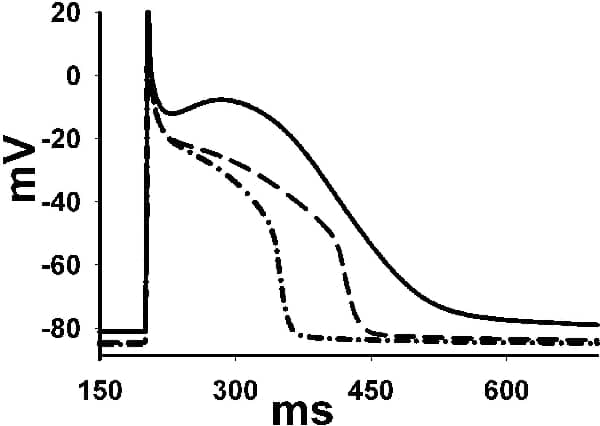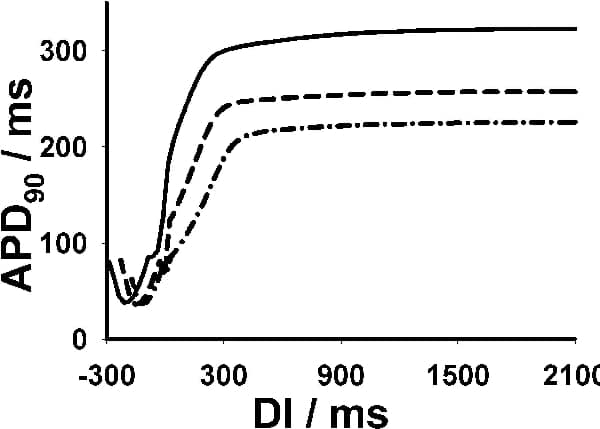Familial atrial fibrillation (AF) has been causatively linked to Kir2.1 V93I gene mutation, which manifests as gain-of-function in IK1 [1]. In this study we evaluated the role of this gene mutation in initiation and maintenance of AF in humans. Experimental data of voltage-dependent increase in IK1 due to Kir2.1 V93I mutation [1] was incorporated into the Courtemanche et al. model of electrical action potential (AP) of human atrial cell for wild (WT), heterozygous (HMT) and mutant conditions (MT). Single cell restitutions in AP and effective refractory period (ERP) were computed using a standard S1-S2 protocol [2]. The single cell model was then incorporated into a partial differential equation to simulate homogeneous 1D and 2D tissues. S1-S2 protocols were used to compute restitution in conduction velocity (CV). In 2D tissue, re-entry was initiated using a cross-field protocol and dynamics characterized using life span (LS), tip meandering and number of wavelets during a 10 s simulation. Increased IK1 abbreviated atrial AP (Fig. 1) and flattened APD (Fig. 2), ERP, and CV restitution curves. It hyperpolarized atrial resting potential and reduced atrial excitability, which resulted in reduction of intra-atrial CV. In the 2D model re-entry self-terminated for WT (LS ~ 3s) and HWT (LS ~ 1.8s) tissues, but persisted in MT (LS >10 s). In all 3 tissue types, re-entry was unstable with breakup and formation of multiple wavelets. Within the same atrial mass (37.5 x 37.5 mm2), the WT and HWT tissues accommodated a maximum of only 3 wavelets, the WT tissue accommodated 7. Tip meander of re-entry was over a larger area in WT and HT tissues than in MT. Gain-of-function of IK1 shortens atrial APD and ERP facilitating re-entrant circuits. It increases LS of re-entrant waves while reducing the meander, thus increasing stability. This study contributes towards understanding how Kir2.1 V93I mutation facilitates and perpetuates AF in humans.
University College London 2006 (2006) Proc Physiol Soc 3, PC39
Poster Communications: Gain-of-function in Kir2.1 and its effects on atrial fibrillation in homogeneous virtual human atrial tissue: a computer simulation study
Sanjay Kharche1, Hannah Moore1, Clifford Garratt2, Jules Hancox3, Henggui Zhang1
1. School of Physics and Astronomy, University of Manchester, Manchester, Lancashire, United Kingdom. 2. Manchester Royal Infirmary, University of Manchester, Manchester, Lancashire, United Kingdom. 3. Department of Physiology, University of Bristol, Bristol, Gloucestershire, United Kingdom.
View other abstracts by:
Figure 1. Changes in APD due to gain-of-function in IK1. WT AP profile is shown as solid line (APD = 322.73 ms) HMT as dashed line (APD = 257.7 ms) and the MT as dashed-dotted line (APD = 225.68 ms). The APD decreased by 20.67 % in HMT case and by 30.24 % in the MT case. Changes in APD associated with gain-of-function in IK1 are not available.
Figure 2. Changes in cell AP restitution due to gain-of-function in IK1. WT restitution is shown as solid line (maximal slope = 2.3) HMT as dashed line (maximal slope = 2.2261) and MT as dashed-dotted line (maximal slope = 0.4608). Changes in restitution associated with gain-of-function in IK1 are not available.
Where applicable, experiments conform with Society ethical requirements.


